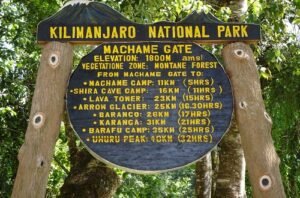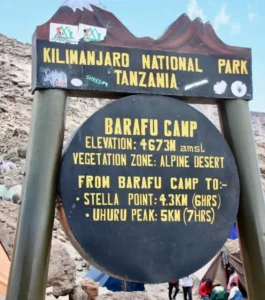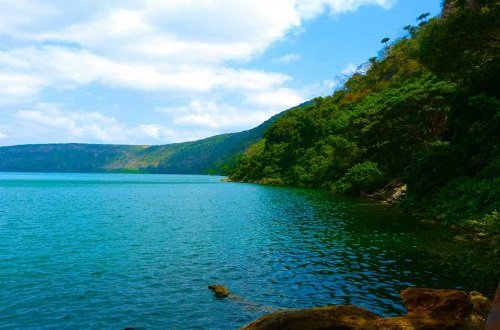Kilimanjaro National Park – Tanzania’s Crown Jewel of Africa
Perched majestically in the northeastern part of Tanzania, Kilimanjaro National Park stands as one of Africa’s most iconic natural wonders. It’s home to Mount Kilimanjaro, the highest peak in Africa and the tallest free-standing mountain in the world, rising dramatically to 5,895 meters (19,341 feet) above sea level.
This UNESCO World Heritage Site is more than just a mountain—it’s a breathtaking blend of ecosystems, wildlife, and cultural heritage that make it one of the most remarkable destinations on the continent.
Whether you’re a thrill-seeker dreaming of conquering the summit, a nature lover looking to explore pristine wilderness, or a cultural traveler eager to connect with local Chagga communities, Kilimanjaro National Park offers an unforgettable experience for everyone.

A Glimpse into Kilimanjaro’s History
Kilimanjaro National Park was established in 1973 and officially opened in 1977, primarily to protect Mount Kilimanjaro and its unique ecosystems. Before becoming a park, the area was managed as a forest reserve dating back to 1921. The park’s main goal has always been to preserve both the biodiversity and cultural significance of this extraordinary region.
In 1987, UNESCO recognized Kilimanjaro National Park as a World Heritage Site, acknowledging its global importance as a natural and ecological treasure. Today, the park is managed by the Tanzania National Parks Authority (TANAPA) and continues to attract tens of thousands of visitors from across the globe each year.
The Mighty Mount Kilimanjaro
Mount Kilimanjaro is the undisputed centerpiece of the park. Known locally as “Kilema Kyaro” (meaning “That which cannot be conquered”), the mountain is a dormant volcano composed of three cones: Kibo, Mawenzi, and Shira. Kibo is the highest and most famous, with its snow-capped peak known as Uhuru Peak — the ultimate goal for climbers worldwide.
Despite its intimidating height, Kilimanjaro is one of the few high mountains that can be climbed without technical mountaineering experience. This accessibility makes it a dream destination for adventure travelers and mountaineers alike.
There are several routes to the summit, including:
- Marangu Route – Known as the “Coca-Cola route,” it’s the most popular and comfortable path with hut accommodations.
- Machame Route – Nicknamed the “Whiskey route,” it offers stunning scenic views but requires good fitness.
- Lemosho Route – A longer and more gradual trail, ideal for acclimatization and fewer crowds.
- Rongai Route – Approaches from the north and is less crowded, offering a more remote experience.
- Umbwe Route – The steepest and most challenging route, suitable for experienced climbers.
Reaching Uhuru Peak rewards climbers with an awe-inspiring sunrise above the African plains—an unforgettable moment described by many as life-changing.
Breathtaking Biodiversity
Kilimanjaro National Park is not only about the mountain itself—it’s a haven of biodiversity. The park spans approximately 1,688 square kilometers, encompassing a wide range of ecosystems that change dramatically with altitude.
- Montane Forest Zone – The lush green forests on the lower slopes are home to monkeys, elephants, leopards, and hundreds of bird species, including turacos and hornbills.
- Heather and Moorland Zone – As you ascend, the vegetation becomes dominated by giant groundsels, heathers, and lobelias that create an otherworldly landscape.
- Alpine Desert Zone – This area is characterized by barren terrain and harsh weather, yet still hosts some resilient plant species.
- Arctic Zone (Summit) – The icy, snow-covered peak gives Kilimanjaro its iconic silhouette. Sadly, scientists warn that the glaciers are receding rapidly due to climate change.
The diversity of habitats makes Kilimanjaro National Park one of Tanzania’s most ecologically fascinating destinations, offering visitors the chance to experience multiple climates and ecosystems in a single journey.
Cultural Heritage and the Chagga People
The slopes of Kilimanjaro are home to the Chagga people, one of Tanzania’s most industrious and hospitable ethnic groups. The Chagga have lived around the mountain for centuries, cultivating coffee, bananas, and other crops in the fertile volcanic soil.
Visiting a Chagga village provides a deeper understanding of local traditions and history. Tourists can explore traditional Chagga houses, learn about coffee farming, and visit the Chagga Caves—historical hideouts used during tribal conflicts in the past. Cultural tours around Moshi town and Marangu village offer an enriching glimpse into the daily lives and warm hospitality of the local communities.
Top Activities to Enjoy in Kilimanjaro National Park
- Mountain Climbing: The ultimate adventure for most visitors is summiting Mount Kilimanjaro.
- Day Hikes: For those not ready for a full climb, shorter hikes to places like Mandara Hut or Shira Plateau offer stunning views and a taste of adventure.
- Wildlife Viewing: Spot animals such as bushbucks, elephants, colobus monkeys, and serval cats in the lower forests.
- Bird Watching: With over 150 bird species, including rare raptors, Kilimanjaro is a paradise for bird enthusiasts.
- Cultural Tours: Experience Chagga traditions, taste local dishes, and learn about coffee processing.
- Photography: Capture breathtaking shots of landscapes, wildlife, and the snow-capped summit against the African sky.

Best Time to Visit Kilimanjaro National Park
The best time to visit Kilimanjaro National Park depends on what you want to experience:
- For Climbing: The dry seasons—January to March and June to October—offer the best weather and clearer views.
- For Wildlife and Nature: The wet seasons (April–May and November) transform the landscape into a lush, green paradise, perfect for photographers and nature lovers, though trails can be muddy.
Regardless of the season, Kilimanjaro’s beauty remains unmatched year-round.
Accommodation Options
There’s a wide range of accommodation around the park, from budget lodges to luxurious resorts:
- Budget: Hostels and guesthouses in Moshi town.
- Mid-range: Comfortable lodges like Marangu Hotel and Chanya Lodge.
- Luxury: High-end options such as Kilimanjaro Mountain Resort and Kaliwa Lodge, offering magnificent views of the mountain.
Campgrounds are also available within the park for climbers following different routes.
How to Get There
The gateway to Kilimanjaro National Park is Moshi town, located about 45 kilometers from Kilimanjaro International Airport (JRO). The airport is easily accessible with flights from major cities like Arusha, Dar es Salaam, Nairobi, and even international connections from Europe and the Middle East.
From Moshi or Arusha, visitors can take taxis, shuttles, or organized tours directly to the park’s gates—such as Marangu Gate, Machame Gate, or Lemosho Gate.

Why Kilimanjaro National Park is the Best in Africa
Kilimanjaro National Park stands out among Africa’s natural wonders not only for its towering peak but also for its extraordinary mix of landscapes, wildlife, and culture. It’s a place where glaciers meet tropical forests, where adventure meets serenity, and where visitors leave with stories that last a lifetime.
From the challenge of conquering the roof of Africa to the peaceful beauty of the foothills and villages below, Kilimanjaro offers something magical for everyone. It’s not just a park—it’s a symbol of Africa’s raw beauty, resilience, and grandeur.
Kilimanjaro National Park is truly Tanzania’s crown jewel and one of the best national parks in Africa. Its diverse ecosystems, cultural richness, and world-famous peak make it a must-visit destination for travelers seeking adventure and natural wonder. Whether you aim to stand atop Uhuru Peak or simply admire its snow-capped majesty from afar, Kilimanjaro leaves every visitor inspired, humbled, and in awe of nature’s power.



